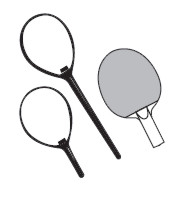You Are Here: Home » History of Table Tennis » A Brief History of the Racket
Table Tennis Racket
A Brief History
The table tennis racket has changed significantly over the years.
Let's take a look at how it's developed...
By Martin Hughes
Owner and Editor

The table tennis racket has changed many times during its 120+ years of development - from the first hollow drum racket to the sophisticated sponge racket of today.
But if you're looking for advice on choosing a racket today, read my articles starting here.
TABLE TENNIS EXPERT
REVEALS HIS SECRETS
Click Here For Details

Click here for a large selection of
table tennis equipment at Megaspin *

Click here for a large selection of
table tennis equipment at Bribar *
^ Top of page ^
But first, let's take a brief look at how we arrived at today's modern racket
1880s - early 1900s
In approximate chronological order, the table tennis racket has developed as follows:
- The long handled vellum battledore, frequently called the "banjo" racket and often as long as 48cm (19 inches).
- Then came a short-handled hollow vellum battledore racket which superseded the long handled model.
- Next, a plain wooden racket which was made of different types of wood and in different thicknesses.
- A racket covered in sandpaper was then developed in an attempt to help players impart spin on the ball.
- A cork-faced racket replaced the sandpaper covered racket, and many players considered it gave improved performance.
TABLE TENNIS EXPERT
REVEALS HIS SECRETS
Click Here For Details

Click here for a large selection of
table tennis equipment at Megaspin *

Click here for a large selection of
table tennis equipment at Bribar *
^ Top of page ^
1920s-1950s
This era saw many changes to the technical specifications of the racket, and for the first time the impact of Japanese technology was experienced by European players.
- Firstly there was a pimpled rubber racket which had a canvas backed rubber sheet with a studded surface.
- The next stage was the production of an extra wide racket which had a surface of pimpled rubber. This racket was often preferred by defensive players.
- In the early 1950s, a waffle sponge racket was introduced.
- The 1950s also saw the first Japanese racket on the European market. This was a 10mm soft sponge racket.
- The introduction of the crepe rubber racket was next but it was unsuccessful because it gave the player little control over the ball.
^ Top of page ^
1960s onwards
This phase of development saw the racket start to evolve into the hi-tech product it is today.
- The first racket in this phase was the 1mm pimpled rubber sponge covered racket, but while this was suitable for all round play,
it did impose limitations on spin.
- This was superseded by the 2mm pimple rubber racket which proved ideal for attacking play, but again limited spin.
- In terms of innovation, the next in line was a racket which was designed to counter topspin by providing a surface which would absorb heavy topspin.
- The maximum degree of spin and speed was produced by a racket which had a 1mm reverse rubber sponge surface.
- And then, for greatest control, the 1mm reverse rubber sponge racket was produced.
^ Top of page ^
| MORE PAGES ABOUT THE HISTORY OF TABLE TENNIS |
|---|
For more information about the history of table tennis, take a look at my other articles...
General history of table tennis
Significant events in the history of table tennis
And... |
Click here for a large selection of
table tennis equipment at Megaspin *

Click here for a large selection of
table tennis equipment at Bribar *
^ Top of page ^
You Are Here: Home » History of Table Tennis » A Brief History of the Racket
